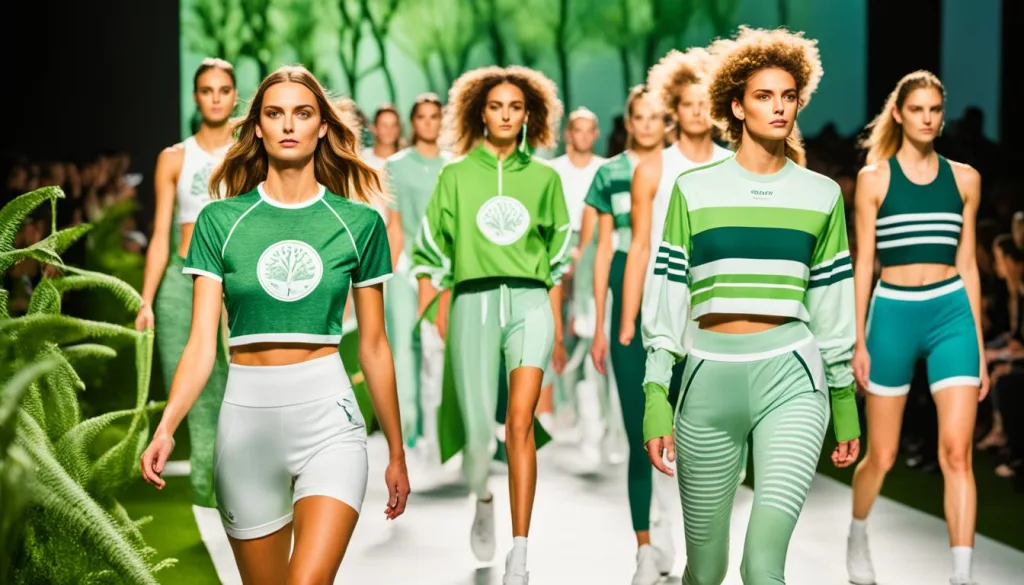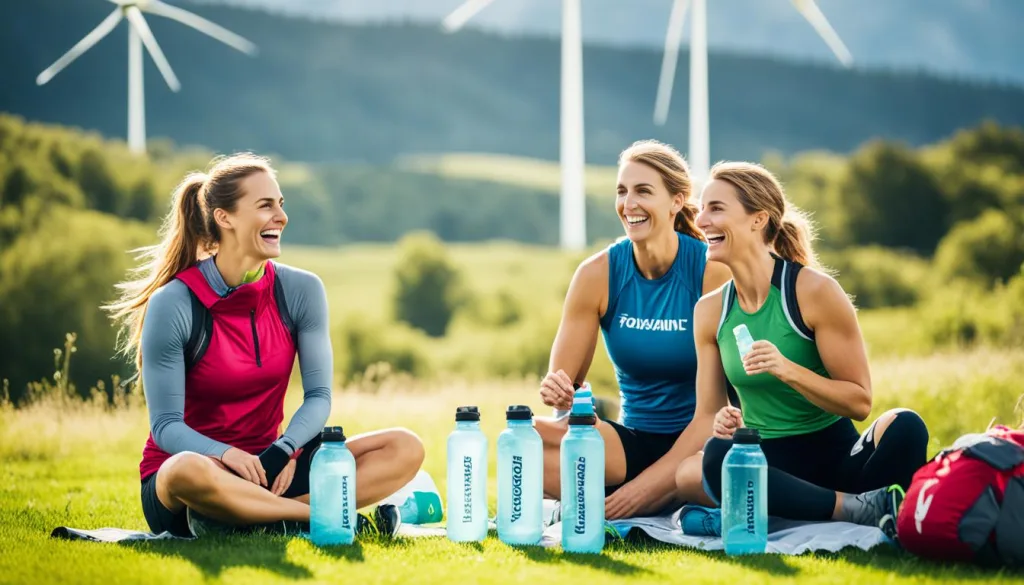Engaging Consumers with Sustainable Sportswear Initiatives
Connect With Us Today
Consider us for your next production run. Why wait? Send us your questions here.
Engaging consumers with sustainable sportswear initiatives is now crucial. It’s more than doing the right thing; it’s smart business. Most apparel in the USA comes from overseas1. So, there’s a big push for eco-friendly activewear. This push helps the planet and global economies. The goal? To cut the environmental harm of products by up to 100% soon1.
This shift to sustainability matches what today’s buyers want. Sadly, people throw away a lot of their clothes each year. This adds to a huge amount of waste1.
Key Takeaways
- Increasing consumer awareness of sustainable apparel practices.
- The urgent need for sustainable production and reduced textile waste.
- Strategies for activewear brands to promote eco-friendly options.
- Consumer trends towards longevity and quality in sportswear purchasing.
- The impact of sustainability goals on brand reputation and profitability.
- Adoption of advances in technology to foster sustainable shopping behaviors.
- The power of consumer choice in steering the apparel industry towards greener practices.
The Evolution of Consumer Attitudes Towards Sustainable Fashion
In the last two decades, fashion isn’t just about style anymore. People are thinking differently about what they buy. They’re looking at how long clothes last and how they’re made. This change is because people care more about the environment and want clothes that are kind to the planet.
The Shift in Garment Life Span and Production
Clothes used to last a long time. But from 2000 to 2015, the amount of clothes made doubled. And the time we keep them dropped a lot. The Ellen MacArthur Foundation found some clothes are thrown away after only 7 to 10 times of wearing2. People want quality and lasting clothes, but fast fashion leads to more waste, which is a big problem.
Also, what clothes are made of is changing. Now, 67% of people think it’s very important for clothes to be made from sustainable materials3.
Identifying Sustainable Consumer Personas
People who buy sustainable fashion are different from each other. For instance, Good Citizen buyers are okay with paying more for eco-friendly clothes. 64% of them said yes to this, but only 24% of the Indifferent group felt the same2. Sustainability Champions, though, are the ones who really care. A huge 84% of them spend more on green products because they value the planet’s health2.
The Attitude-Behavior Gap in Sustainable Consumption
Even though people care more about green fashion, it doesn’t always mean they buy it. Only a few always think “green” when they shop2. And it gets harder to tell what’s truly sustainable as you get older. A third of shoppers find this tough. Plus, since COVID-19, 70% trust familiar brands more, even over new eco-friendly options3.
To fix this, fashion brands need to do three things. They should be clearer about how they’re green, talk about why their durable products are good, and make buying green easier and more attractive2.

As people’s views on eco-friendly fashion keep changing, brands must listen and connect with these beliefs. This will help close the gap between caring and actual buying, moving us towards better shopping habits.
Integrating Sustainability into Activewear Market Strategies

The clothing and footwear industry has a huge impact on the environment, especially in water pollution. It pollutes around 200 tons of water for each ton of fabric4. As the industry faces these challenges, sustainability in activewear becomes key. It’s not just about cutting down on CO2 emissions from fast fashion4. It’s also about meeting the needs of the 66% of consumers, and 75% of millennials, who value sustainability when they shop5. This highlights the need for eco-friendly activewear market strategies.
There are no set rules for sustainable consumption in this industry yet4. So, brands have a big chance, and duty, to create and use strategies that both people and the planet need. These strategies should cover everything from what to consider before buying to how to care for items afterward. This includes telling people how to wash their activewear in a way that uses less energy and water4. Also, using social influence can play a big role in making sustainable fashion more popular4.
- Use of recycled materials and organic fibers in manufacturing
- Investment in renewable energy for production to align with countries like Costa Rica, Iceland, and Sweden, which boast nearly 100% renewable energy utilization5
- Incorporation of circular economy principles, ensuring that end-of-life garments are recycled or upcycled effectively
- Collaborations with environmental organizations to work on conservation and awareness projects
- Transparent communication with consumers about eco-friendly practices
Sustainable practices are leading to new ideas in the activewear world4. The goal for these brands is to not just adjust, but to lead. Every step of making and using a product should think about the environment. The sportswear market is predicted to grow to $305.67 billion by 20305. This is a huge chance for brands that make sustainability a core part of what they do.
| Strategy | Description | Consumer Impact |
|---|---|---|
| Eco-materials | Utilization of low-impact, sustainable materials in production. | Appeals to conscious consumers, reduces environmental harm. |
| Renewable Energy Adoption | Use of renewable energy sources for manufacturing processes. | Aligns with global sustainability goals, sets industry benchmarks5. |
| Circular Fashion | Implementation of take-back or recycling programs for end-of-life products. | Promotes long-term sustainability, involves consumers in eco-lifecycle. |
| Educational Initiatives | Provide information on sustainable practices and care for apparel. | Empowers informed choices, leads to more sustainable usage and care. |
We need to encourage everyone to buy sustainably through education and rewards for making green choices. The huge growth in clothes buying over the last twenty years5 means we have to change to sustainable ways that we all can follow.
Engaging Consumers with Sustainable Sportswear Initiatives
The sportswear industry is moving towards sustainability due to rising environmental worries. However, embracing this green path comes with challenges. It’s crucial for brands to connect with shoppers in ways that change their buying habits.
Translating Environmental Concern into Consumer Action
Since 2004, clothing production has soared6. Addressing the environmental damage from this boom is essential. Today’s shoppers are eco-aware and tend to buy new clothes after wearing them a few times6. H&M, owning over 5,000 stores, is switching to recycled materials aiming for complete sustainability by 20307. Adopting WRI’s sustainable goals shows companies are serious about environmental concerns6.
Enhancing Quality and Durability Perception
There’s a myth that sustainable clothes lack in quality or last less. By highlighting the strong connection between sustainability and high quality, brands can dispel these doubts. For example, Uniqlo uses recycled fabrics and supports green initiatives, making this clear in their marketing and stores7. This approach boosts the image of sustainable sportswear’s quality and value.
Overcoming Barriers to Sustainable Shopping
Making sustainable choices affordable is a major challenge. Low pay in places like Ethiopia and Bangladesh highlights the economic hurdles for workers and buyers6. Introducing apparel reuse models can make sustainability more appealing to the masses6. It’s also important for companies to avoid greenwashing, ensuring their eco-friendly claims are real. Zara’s goal for 100% renewable energy by 2030 shows their true commitment to the environment7. These actions can help shoppers overcome doubts about sustainable sportswear.
By addressing environmental concerns, promoting the quality and longevity of products, and clearly communicating the steps to overcome shopping barriers, the sportswear sector can truly connect with customers on sustainability. This effort goes beyond just selling clothes; it’s about fostering a culture of conservation and accountability. This is key for engaging consumers with sustainable sportswear initiatives.
Best Practices for Communicating Eco-Friendly Values
It’s vital to share eco-friendly values effectively, as US consumers spend over $14 trillion yearly. This spending makes up nearly two-thirds of the US GDP8. Today, 78% of US consumers want to live sustainably8. So, brands need to connect with this desire through clear, honest messaging. This approach is especially important for wealthier households and city dwellers. They are more likely to buy products that are kinder to the planet8.
For sustainable fashion, it’s about more than just what you say. It’s about making real changes and showing true dedication. Almost all leading companies now report on their sustainability efforts9. This sets a high bar for openness. Also, with a 71% increase in online searches for sustainable goods in five years9, people are actively seeking these products. ESG-related items now account for almost half of all retail sales. They are growing faster than products without these claims in many areas8.
To win over consumers ready to shop more sustainably9, brands must make sustainability a key part of their identity. The story of a brand’s green commitment should stay the same everywhere. This way, 90% of Gen Z buyers, who recently chose a sustainable product, can connect with and back these brands9. By adopting green practices, brands can meet consumer demand. This is shown by the 71% of adults worldwide who prefer to work for eco-conscious companies9. Such practices help secure a lasting, thriving economy in the sector of consumer goods. This field employs millions and creates trillions in yearly revenue8.
FAQ
What are sustainable sportswear initiatives?
Why is sustainability important in the fashion industry?
How do consumer attitudes impact the demand for sustainable fashion?
How can brands integrate sustainability into their activewear market strategies?
How can brands engage consumers with sustainable sportswear initiatives?
What are best practices for communicating eco-friendly values to consumers?
Source Links
- https://www.mdpi.com/2071-1050/13/19/10655
- https://www.bain.com/insights/how-brands-can-embrace-the-sustainable-fashion-opportunity/
- https://www.mckinsey.com/industries/retail/our-insights/survey-consumer-sentiment-on-sustainability-in-fashion
- https://www.mdpi.com/2071-1050/12/7/2788
- https://vistatec.com/sustainability-in-sportswear-communicating-green-initiatives/
- https://www.wri.org/initiatives/sustainable-and-ethical-apparel
- https://earth.org/fast-fashion-brands-greenwashing/
- https://www.mckinsey.com/industries/consumer-packaged-goods/our-insights/consumers-care-about-sustainability-and-back-it-up-with-their-wallets
- https://execsintheknow.com/magazines/july-2023-issue/the-rise-of-environmentally-conscious-consumers-cx-reimagined-for-sustainability/
Latest News
How Collaboration Shapes Consumer Preferences in Sportswear
Navigating Consumer Rights and Warranties in Sportswear Sales
Artificial Intelligence in Fashion Forecasting and Trend Analysis
The Shift Towards Inclusive Sizing in Sportswear: Consumer Reactions
The Global Expansion of Luxury Sportswear Brands
From Sketch to Gym: The Design Process of Fashionable Sportswear
Understanding the Role of Trade Associations in Sportswear Compliance
How Economic Trends Influence Consumer Spending on Sportswear
Learning from Successful Global Market Entries
Best Practices for Managing Cross-Cultural Teams
Using Technology to Fight Counterfeit Fashion Products
Carbon Nanotube Fabrics for Superior Strength and Flexibility
The Growth of Fitness Tracking Apparel in Health and Wellness
Exploring the Influence of Social Proof in Sportswear Purchasing
Strategies for Managing Compliance in a Multinational Operation
Trends in Global Footwear: Performance Meets Lifestyle
The Role of Artificial Intelligence in Tracking Supply Chain Operations
Evaluating the Success of Sportswear Collaborative Projects
Evaluating the Potential of Emerging Markets
Global Shifts Towards Gender-Neutral Sportswear
Share This Article
Latest Articles



















